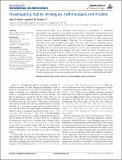Investigating habits: strategies, technologies and models
Author(s)
Smith, Kyle S.; Graybiel, Ann M.
DownloadSmith-2014-Investigating habits.pdf (862.5Kb)
PUBLISHER_POLICY
Publisher Policy
Article is made available in accordance with the publisher's policy and may be subject to US copyright law. Please refer to the publisher's site for terms of use.
Terms of use
Metadata
Show full item recordAbstract
Understanding habits at a biological level requires a combination of behavioral observations and measures of ongoing neural activity. Theoretical frameworks as well as definitions of habitual behaviors emerging from classic behavioral research have been enriched by new approaches taking account of the identification of brain regions and circuits related to habitual behavior. Together, this combination of experimental and theoretical work has provided key insights into how brain circuits underlying action-learning and action-selection are organized, and how a balance between behavioral flexibility and fixity is achieved. New methods to monitor and manipulate neural activity in real time are allowing us to have a first look “under the hood” of a habit as it is formed and expressed. Here we discuss ideas emerging from such approaches. We pay special attention to the unexpected findings that have arisen from our own experiments suggesting that habitual behaviors likely require the simultaneous activity of multiple distinct components, or operators, seen as responsible for the contrasting dynamics of neural activity in both cortico-limbic and sensorimotor circuits recorded concurrently during different stages of habit learning. The neural dynamics identified thus far do not fully meet expectations derived from traditional models of the structure of habits, and the behavioral measures of habits that we have made also are not fully aligned with these models. We explore these new clues as opportunities to refine an understanding of habits.
Date issued
2014-02Department
Massachusetts Institute of Technology. Department of Brain and Cognitive Sciences; McGovern Institute for Brain Research at MITJournal
Frontiers in Behavioral Neuroscience
Publisher
Frontiers Research Foundation
Citation
Smith, Kyle S., and Ann M. Graybiel. “Investigating Habits: Strategies, Technologies and Models.” Front. Behav. Neurosci. 8 (2014).
Version: Final published version
ISSN
1662-5153